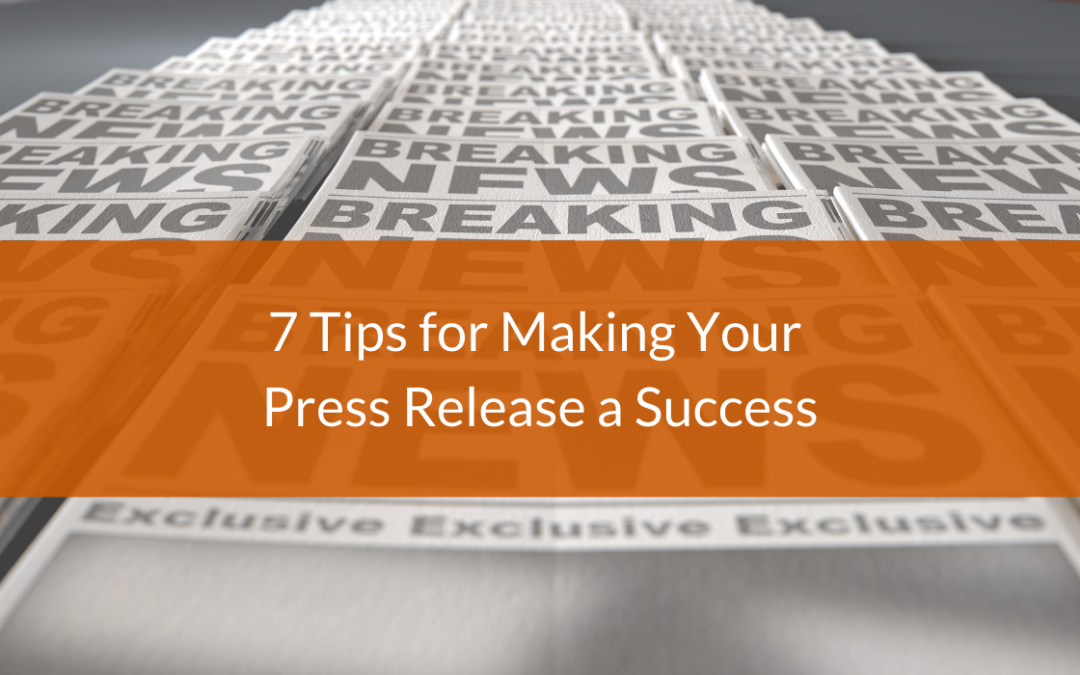
7 Tips for Making Your Press Release a Success
Most journalists (36%) still receive their news from the good old press release. As a PR professional, you are responsible for getting the news your client wants to disseminate in front of as many relevant people as possible.
But in 2020 when the usual news topics have been turned on their head, how do you do that?
PR Newswire – a Cision company – released its State of Press Release report which noted that 48% of all releases issued between March and May 2020 mentioned COVID-19.
The report also provided these statistics when comparing 2019 and 2020 news topics:
- Future events news dropped 56%
- Trade show news releases dropped by 77%
- Public safety news increased by 192%
- Corporate social responsibility releases increased by 118%
- News about infectious disease control saw a huge jump of 3,140%
If your client’s release is either in a category that isn’t being discussed, or included in a topic that’s likely to get lost in the shuffle, how do you ensure yours stands out?
Here are seven tips to give you an edge.
1. Start at the top with a short, newsy headline. A short and catchy headline is where you capture audience attention. After all, when you scroll through a newspaper, social media platform, or newsletter, what is it that makes you decide which articles to read?
The average headline length for a press release is 88 characters. Keep headlines short and sweet, and if it’s absolutely necessary for a longer headline, ensure the important keywords are in the first 70 characters because this is where Google search engine results and email subject lines cut off.
2. Use strong call-to-action words. According to the PR Newswire / Cision State of the Press Release report, these are the top 10 CTA headline words:
- Confirms
- Reveals
- Proves
- Launches
- Empowers
- Enables
- Allows
- Announces
- Rolls Out
- Shows
3. Select the right newswire company. At our agency, we have been working with PR Newswire for many years. We have experience with all the wires, but we feel this company has an edge.
Not only do they have superior customer service, their wires syndicate to more outlets than any other. Additionally, they have a service in which editors pay to subscribe to their wires.
It gives those looking for news the chance to eliminate a mass download to their inbox, and it provides search terms. Therefore, when we set up releases to be sent on the wire, we use an option provided by PR Newswire, in which we “code” for keywords and trades. This allows the right people to find the news they are actively looking for to write into their story lines.
4. Pick the right time to send your news. According to Cision, the highest volume of news is sent at 8 AM ET, Mondays through Thursdays with Tuesday being the highest day of release traffic. 52% of copy is sent at the top or bottom of the hour.
So, to stand out from the flood of releases being pushed, yours should be sent either before or after 8 AM ET. If you’re looking to maximize your visibility, the best days are Tuesday, Wednesday, or Thursday in the middle of the day. Use odd times like 9:05 am, or 1:10 pm.
5. Make content informative and engaging. The average press release according to Cision’s data, is 686 words and readers spent 3 minutes and 39 seconds. But it won’t get read at all if it doesn’t interest the media. This blog post by my colleague Michelle Noteboom provides tips for tweaking your message to ensure the audience hears you – during COVID-19 and beyond.
6. Don’t rely on the wire alone – pitch away! Hopefully, you’re working with an experienced PR agency who has a great media relations team. I pulled this entire paragraph from Cision’s report because I found it compelling:
“For the first time in Cision’s State of the Media Report history, we asked reporters to share what days they receive pitches most and what days they actually prefer getting them. As many of us expected, Mondays proved to be the preferred day for reporters, and it was also when they got pitches most. However, many journalists reported they were still open to receiving pitches until Friday (a handful even on Saturday and Sunday). As the week progresses though, the number of pitches they receive declines. While their interest in receiving pitches did slightly decrease, the numbers weren’t so significant that it should prevent publicists from reaching out.”
7. Look outside the box for other ways to promote your news. Ensure the client is posting the release on their website. Use your social media team to create multiple, engaging posts for all the client’s social platforms. And if your client is a member or sponsor of any publication or trade organization, find out if benefits include posting corporate news.
New hire announcements, contract wins, and product launches all make for news-worthy events. In the world of health and health IT, we look to publications such as HIStalk, Answers Media and DOTmed, and trade organizations including AHIP, CHIME and the ATA for posting our clients’ press releases.
2020 hasn’t been an easy year. But with a little extra work and attention to detail, you can ensure your press release is picked up and read by as many people as possible.

